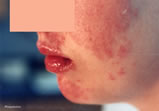U.C.L.A. Rheumatology Pathophysiology of Disease Course Lecture,
Second Year Medical School 1997
Systemic Lupus Erythematosus Page 7
Systemic Lupus Erythematosus
written by:
Peng Thim Fan, M.D.
graphics by:
Craig
Wiesenhutter,
M.D.
The genetic predisposing factors in SLE are not well understood. The condition is more common in monozygotic twins than other family members but recent studies show that the concordance rate in monozygotic twins is only 24%. There is occasional familial clustering of the disease and the HLA phenotype A1,B8,DR3 is associated with a higher frequency of SLE.

The most famous of these antibodies is the antinuclear antibody (ANA), which reacts against the nucleus of the patient's own cells. ANAs are found in the serum of 99% of patients with SLE. They constitute a group of heterogeneous antibodies which react against different components of the nucleus, such as single-stranded DNA, double-stranded DNA, and the nuclear histone proteins. ANAs may be found in other autoimmune diseases including RA, but antibodies to double-stranded DNA and to an RNA-protein complex called Sm are unique to SLE. Many subsets of anti-DNA antibodies are produced in SLE but only certain ones are believed to be able to induce tissue damage, typically renal disease. These disease-causing antibodies have high pI and they are produced by a restricted repertoire of immunoglobulin genes. In the future, modification of the generation of these pathogenic antibodies may lead to control of the tissue damage.
Another ANA, anti-SSA, is directed against a soluble nuclear antigen. It can cross the placenta of a pregnant SLE patient and bind to the fetal cardiac conduction system, resulting in congenital heart block.